Design and Characterization of a Novel Core–Shell Nano Delivery System Based on Zein and Carboxymethylated Short-Chain Amylose for Encapsulation of Curcumin
Abstract
1. Introduction
2. Materials and Method
2.1. Materials
2.2. Preparation of Carboxymethylated Short-Chain Amylose
2.3. Preparation of Curcumin-Loaded zein@CSA Core–Shell Nanoparticles
2.4. Size and Charge of zein@CSA Core–Shell Nanoparticles
2.5. Encapsulation Efficiency (EE) and Loading Capacity (LC) of Curcumin
2.6. Fourier-Transform Infrared Spectroscopy
2.7. X-ray Diffraction
2.8. Fluorescence Spectroscopy Analysis
2.9. Transmission Electron Microscopy Analysis
2.10. Ionic Stability
2.11. Release Properties
2.12. Antioxidant Activities
2.13. In Vitro Cytotoxicity Assays
2.14. Statistical Analysis
3. Results and Discussion
3.1. Particle Size and Zeta-Potential Characteristics
3.2. Encapsulation Efficiency (EE) and Loading Capacity (LC)
3.3. Fourier Transform Infrared Spectroscopy
3.4. XRD
3.5. Fluorescence Spectroscopy
3.6. Transmission Electron Microscopy
3.7. Ionic Stability Analysis
3.8. Antioxidant Activity
3.9. Release Behavior of the Nanoparticles
3.10. In Vitro Cytotoxicity
4. Conclusions
Author Contributions
Funding
Institutional Review Board Statement
Informed Consent Statement
Data Availability Statement
Conflicts of Interest
References
- Pan, Y.; Wu, Z.; Zhang, B.; Li, X.M.; Meng, R.; Chen, H.Q.; Jin, Z.Y. Preparation and characterization of emulsion stabilized by octenyl succinic anhydride-modified dextrin for improving storage stability and curcumin encapsulation. Food Chem. 2019, 294, 326–332. [Google Scholar] [CrossRef] [PubMed]
- Pan, Y.; Li, X.M.; Meng, R.; Zhang, B. Exploration of the stabilization mechanism and curcumin bioaccessibility of emulsions stabilized by whey protein hydrolysates after succinylation and glycation in different orders. J. Agric. Food Chem. 2020, 68, 623–632. [Google Scholar] [CrossRef] [PubMed]
- Liu, C.R.; Xu, B.; McClements, D.J.; Xu, X.F.; Cui, S.; Gao, L.; Dai, L. Properties of curcumin-loaded zein-tea saponin nanoparticles prepared by antisolvent co-precipitation and precipitation. Food Chem. 2022, 391, 133224. [Google Scholar] [CrossRef] [PubMed]
- Ji, N.; Hong, Y.; Gu, Z.B.; Cheng, L.; Li, Z.; Li, C.M. Chitosan coating of zein-carboxymethylated short-chain amylose nanocomposites improves oral bioavailability of insulin in vitro and in vivo. J. Control. Release 2019, 313, 1–13. [Google Scholar] [CrossRef] [PubMed]
- Rostamabadi, H.; Falsafi, S.R.; Jafari, S.M. Starch-based nanocarriers as cutting-edge natural cargos for nutraceutical delivery. Trends Food Sci. Technol. 2019, 88, 397–415. [Google Scholar] [CrossRef]
- Sun, Y.; Wei, Z.; Xue, C. Development of zein-based nutraceutical delivery systems: A systematic overview based on recent researches. Food Hydrocoll. 2023, 137, 108368. [Google Scholar] [CrossRef]
- Liu, G.J.; An, D.Y.; Li, J.; Deng, S. Zein-based nanoparticles: Preparation, characterization, and pharmaceutical application. Front. Pharmacol. 2023, 14, 1120251. [Google Scholar] [CrossRef] [PubMed]
- Geng, S.; Zhang, X.; Luo, T.; Jiang, M.; Chu, C.; Wu, L.; Zhou, W. Combined chemotherapy based on bioactive black phosphorus for pancreatic cancer therapy. J. Control. Release 2023, 354, 889–901. [Google Scholar] [CrossRef] [PubMed]
- Wei, Y.; Guo, A.; Liu, Z.; Mao, L.; Yuan, F.; Gao, Y.; Mackie, A. Structural design of zein-cellulose nanocrystals core–shell microparticles for delivery of curcumin. Food Chem. 2021, 357, 129849. [Google Scholar] [CrossRef] [PubMed]
- Wang, C.; Wang, L.; An, S.; Jiang, Q.; Gao, D.; Li, X. Construction of porous materials from Pickering high internal-phase emulsions stabilized by zein-hohenbuehelia serotina polysaccharides nanoparticles and their adsortion performances. Food Hydrocoll. 2023, 134, 108101. [Google Scholar] [CrossRef]
- Hu, B.; Han, L.; Ma, R.; Phillips, G.O.; Nishinari, K.; Fang, Y. All-natural food-grade hydrophilic–hydrophobic core–shell microparticles: Facile fabrication based on gel-network-restricted antisolvent method. ACS Appl. Mater. Interfaces 2019, 11, 11936–11946. [Google Scholar] [CrossRef] [PubMed]
- Zhang, S.K.; He, Z.Y.; Xu, F.Z.; Cheng, Y.; Waterhouse, G.I.N.; Waterhouse, D.; Wu, P. Enhancing the performance of konjac glucomannan films through incorporating zein–pectin nanoparticle-stabilized oregano essential oil Pickering emulsions. Food Hydrocoll. 2022, 124, 107222. [Google Scholar] [CrossRef]
- Jiang, F.; Yang, L.; Wang, S.; Ying, X.; Ling, J.; Ouyang, X.K. Fabrication and characterization of zein-alginate oligosaccharide complex nanoparticles as delivery vehicles of curcumin. J. Mol. Liq. 2021, 342, 116937. [Google Scholar] [CrossRef]
- Zhang, G.S.; Qin, M.D.; Guo, M.R.; Li, M.; Zhang, D.; Sun, Y.C.; Liu, B.Y.; He, Z.G.; Fu, Q. Thiol-modified hyaluronic acid improves the physical stability of curcumin-zein nanoparticles by forming disulfide bonds with zein. Food Chem. 2023, 429, 136858. [Google Scholar] [CrossRef] [PubMed]
- Li, H.; Wang, D.; Liu, C.; Zhu, J.; Fan, M.; Sun, X.; Cao, Y.P. Fabrication of stable zein nanoparticles coated with soluble soybean polysaccharide for encapsulation of quercetin. Food Hydrocoll. 2019, 87, 342–351. [Google Scholar] [CrossRef]
- Li, H.; Yuan, Y.; Zhu, J.; Wang, T.; Wang, D.; Xu, Y. Zein/soluble soybean polysaccharide composite nanoparticles for encapsulation and oral delivery of lutein. Food Hydrocoll. 2020, 103, 105715. [Google Scholar] [CrossRef]
- Masina, N.; Choonara, Y.E.; Kumar, P.; Toit, L.C.; Govender, M.; Indermun, S.; Pillay, V. A review of the chemical modification techniques of starch. Carbohydr. Polym. 2017, 157, 1226–1236. [Google Scholar] [CrossRef] [PubMed]
- Ji, N.; Hong, Y.; Gu, Z.B.; Cheng, L.; Li, Z.; Li, C.M. Preparation and characterization of insulin-loaded zein/carboxymethylated short-chain amylose complex nanoparticles. J. Agric. Food Chem. 2018, 66, 9335–9343. [Google Scholar] [CrossRef] [PubMed]
- Liu, Q.; Li, F.; Lu, H.; Li, M.; Liu, J.; Zhang, S.L.; Sun, Q.J.; Xiong, L. Enhanced dispersion stability and heavy metal ion adsorption capability of oxidized starch nanoparticles. Food Chem. 2018, 242, 256–263. [Google Scholar] [CrossRef] [PubMed]
- Zhong, W.; Li, J.; Dai, J.; Wang, C.; Zhang, T. Digestibility of polymerized whey protein using in vitro digestion model and antioxidative property of its hydrolysate. Food Biosci. 2021, 42, 101109. [Google Scholar] [CrossRef]
- Sharma, N.; Kaur, G.; Khatkar, S.K. Optimization of emulsification conditions for designing ultrasound assisted curcumin loaded nanoemulsion: Characterization, antioxidant assay and release kinetics. LWT-Food Sci. Technol. 2021, 141, 110962. [Google Scholar] [CrossRef]
- Li, C.C.; Chen, L.; McClements, D.J.; Peng, X.W.; Qiu, C.; Long, J.; Ji, H.Y.; Zhao, J.W.; Zhou, X.; Jin, Z.Y. Preparation and Characterization of Rutin-Loaded Zein-Carboxymethyl Starch Nanoparticles. Foods 2022, 11, 2827. [Google Scholar] [CrossRef] [PubMed]
- Meng, R.; Wu, Z.; Xie, Q.T.; Cheng, J.S.; Zhang, B. Preparation and characterization of zein/carboxymethyl dextrin nanoparticles to encapsulate curcumin: Physicochemical stability, antioxidant activity and controlled release properties. Food Chem. 2021, 340, 127893. [Google Scholar] [CrossRef] [PubMed]
- Dai, L.; Li, R.; Wei, Y.; Sun, C.; Mao, L.; Gao, Y.X. Fabrication of zein and rhamnolipid complex nanoparticles to enhance the stability and in vitro release of curcumin. Food Hydrocoll. 2018, 77, 617–628. [Google Scholar] [CrossRef]
- Luo, Y.C.; Wang, T.Y.; Teng, Z.; Chen, P.; Sun, J.H.; Wang, Q. Encapsulation of indole-3-carbinol and 3,3′-diindolylmethane in zein/carboxymethyl chitosan nanoparticles with controlled release property and improved stability. Food Chem. 2013, 139, 224–230. [Google Scholar] [CrossRef] [PubMed]
- Wang, T.R.; Ma, X.; Lei, Y.; Luo, Y. Solid lipid nanoparticles coated with cross-linked polymeric double layer for oral delivery of curcumin. Colloids Surf. B Biointerfaces 2016, 148, 1–11. [Google Scholar] [CrossRef] [PubMed]
- Du, J.; Hong, Y.; Cheng, L.; Gu, Z.B. Complexation behavior of carboxymethyl short-chain amylose and quaternized chitosan. Int. J. Biol. Macromol. 2022, 209, 1914–1921. [Google Scholar] [CrossRef] [PubMed]
- Ye, G.Y.; Wu, T.L.; Li, Z.H.; Teng, M.L.; Ma, L.X.; Qin, M.D.; Zhao, P.X.; Fu, Q. Preparation and characterization of novel composite nanoparticles using zein and hyaluronic acid for efficient delivery of naringenin. Food Chem. 2023, 417, 135890. [Google Scholar] [CrossRef] [PubMed]
- Chang, C.; Wang, T.R.; Hu, Q.B.; Luo, Y.C. Zein/caseinate/pectin complex nanoparticles: Formation and characterization. Int. J. Biol. Macromol. 2017, 104, 117–124. [Google Scholar] [CrossRef] [PubMed]
- Patel, A.; Hu, Y.; Tiwari, J.K.; Velikov, K.P. Synthesis and characterisation of zein–curcumin colloidal particles. Soft Matter 2010, 6, 6192–6199. [Google Scholar] [CrossRef]
- Li, Z.P.; Lin, Q.Q.; McClements, D.J.; Fu, Y.; Xie, H.; Li, T.; Chen, G. Curcumin-loaded core-shell biopolymer nanoparticles produced by the pH-driven method: Physicochemical and release properties. Food Chem. 2021, 355, 129686. [Google Scholar] [CrossRef] [PubMed]
- Zhang, H.H.; Liu, R.; Wang, J.; Cui, S.W.; Wang, S.; Wang, B.; Wang, H. Fabrication, characterization, and lipid-lowering effects of naringenin-zein-sodium caseinate-galactosylated chitosan nanoparticles. Int. J. Biol. Macromol. 2023, 230, 123150. [Google Scholar] [CrossRef]
- Zhang, Z.H.; Hu, Y.; Ji, H.Y.; Lin, Q.Z.; Li, X.; Sang, S.; Qiu, C. Physicochemical stability, antioxidant activity, and antimicrobial activity of quercetin-loaded zein nanoparticles coated with dextrin-modified anionic polysaccharides. Food Chem. 2023, 415, 135736. [Google Scholar] [CrossRef]
- Yan, S.Z.; Wang, Q.; Zhang, S.; Huang, Y.Y.; Zhu, H.P.; Qi, B.K.; Li, Y. Oxidized dextran improves the stability and effectively controls the release of curcumin loaded in soybean protein nanocomplexes. Food Chem. 2024, 431, 137089. [Google Scholar] [CrossRef] [PubMed]
- Li, X.J.; Xu, T.; Wu, C.; Fan, G.; Li, T.; Wang, Y.; Zhou, D. Fabrication and characterization of self-assembled whey protein isolate/short linear glucan core–shell nanoparticles for sustained release of curcumin. Food Chem. 2023, 407, 135124. [Google Scholar] [CrossRef] [PubMed]
- Lu, Y.Q.; An, D.; Lv, W.X.; Cai, X.; Ma, F.M.; Li, D. Fucoidan extracted by different methods and bound to zein loaded curcumin nanoparticles: Preparation, physicochemical stability, and in vitro functions. Food Biosci. 2023, 53, 102576. [Google Scholar] [CrossRef]
- Sabet, S.; Rashidinejad, A.; Qazi, H.J.; McGillivray, D.J. An efficient small intestine-targeted curcumin delivery system based on the positive-negative-negative colloidal interactions. Food Hydrocoll. 2021, 111, 106375. [Google Scholar] [CrossRef]
- Andrea, R.D.R.; Julia, K.K.; Remko, M.B.; Anja, E.M.J. Protein acidification and hydrolysis by pepsin ensure efficient trypsin-catalyzed hydrolysis. Food Funct. 2021, 12, 4570–4581. [Google Scholar]
- Li, M.; Yu, M.H. Development of a nanoparticle delivery system based on zein/polysaccharide complexes. J. Food Sci. 2020, 85, 4108–4117. [Google Scholar] [CrossRef] [PubMed]
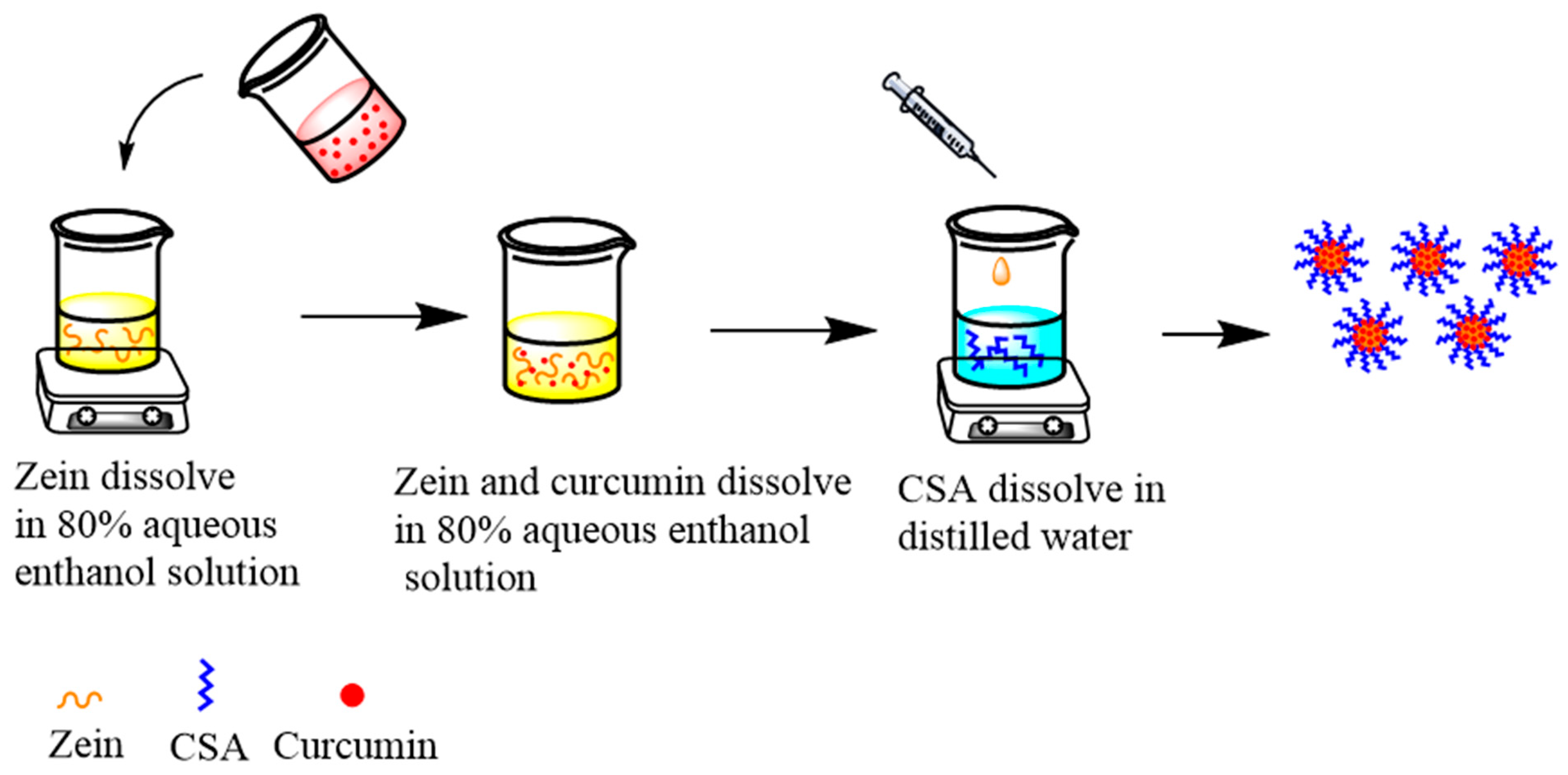

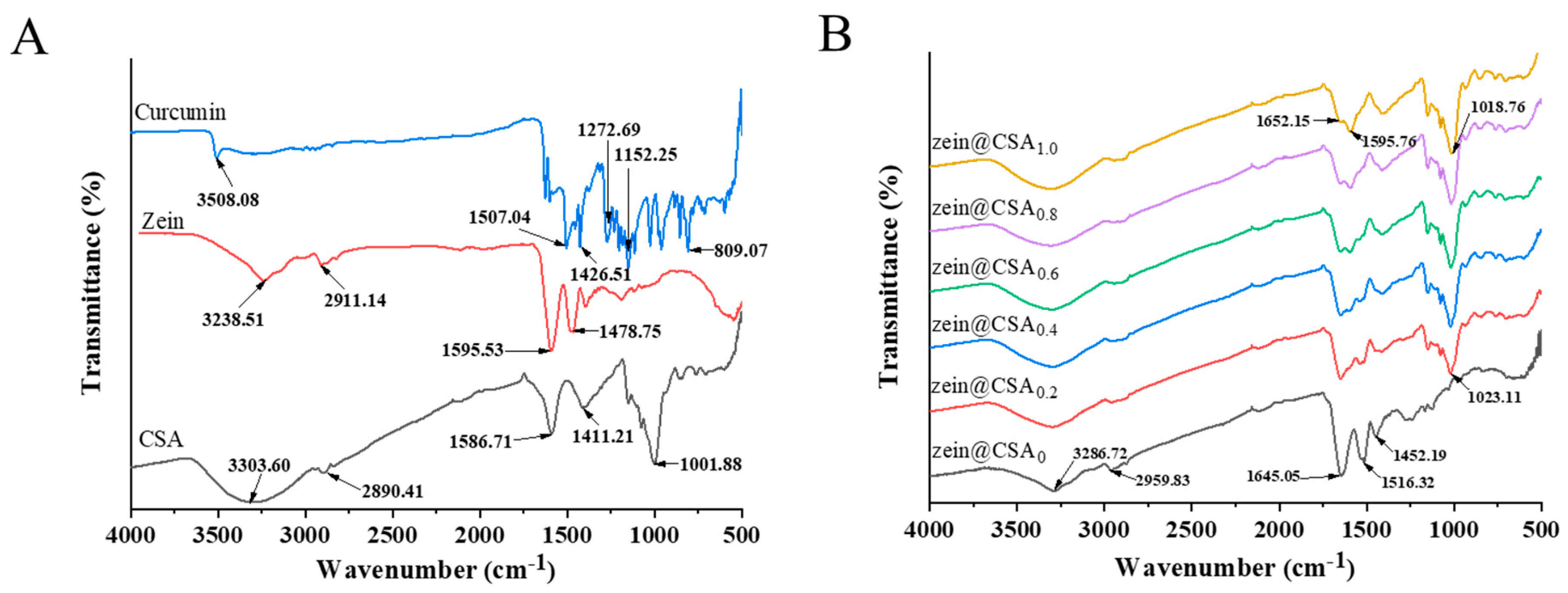


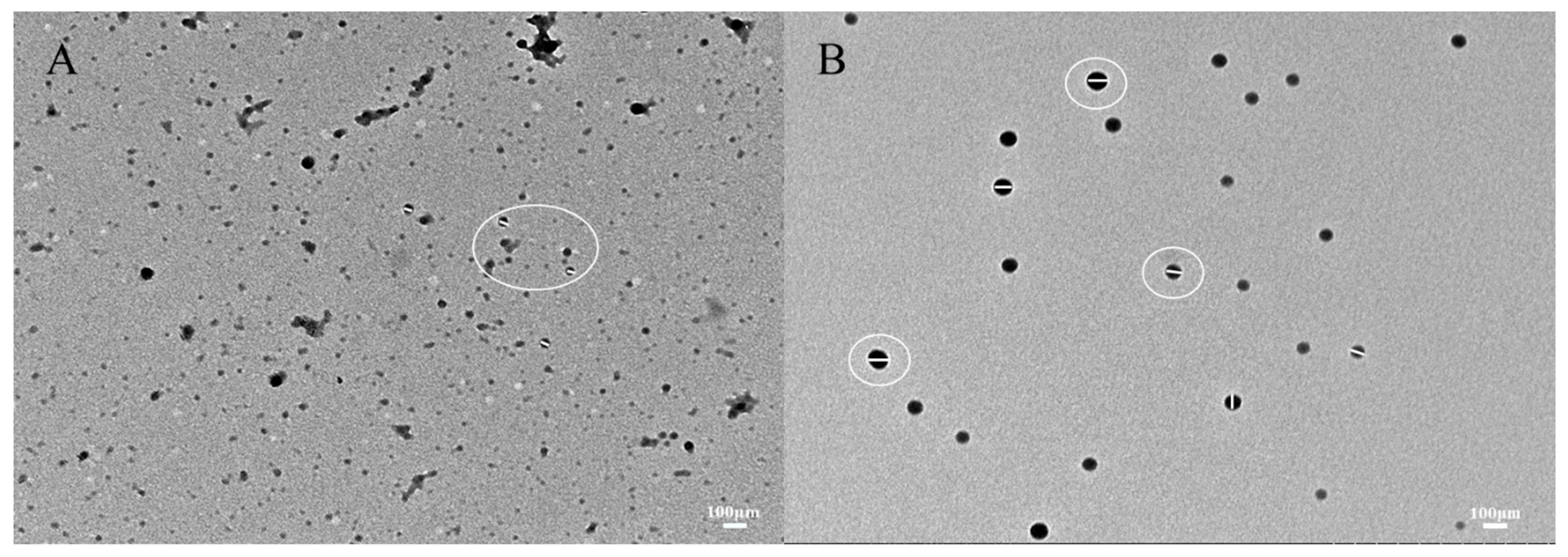
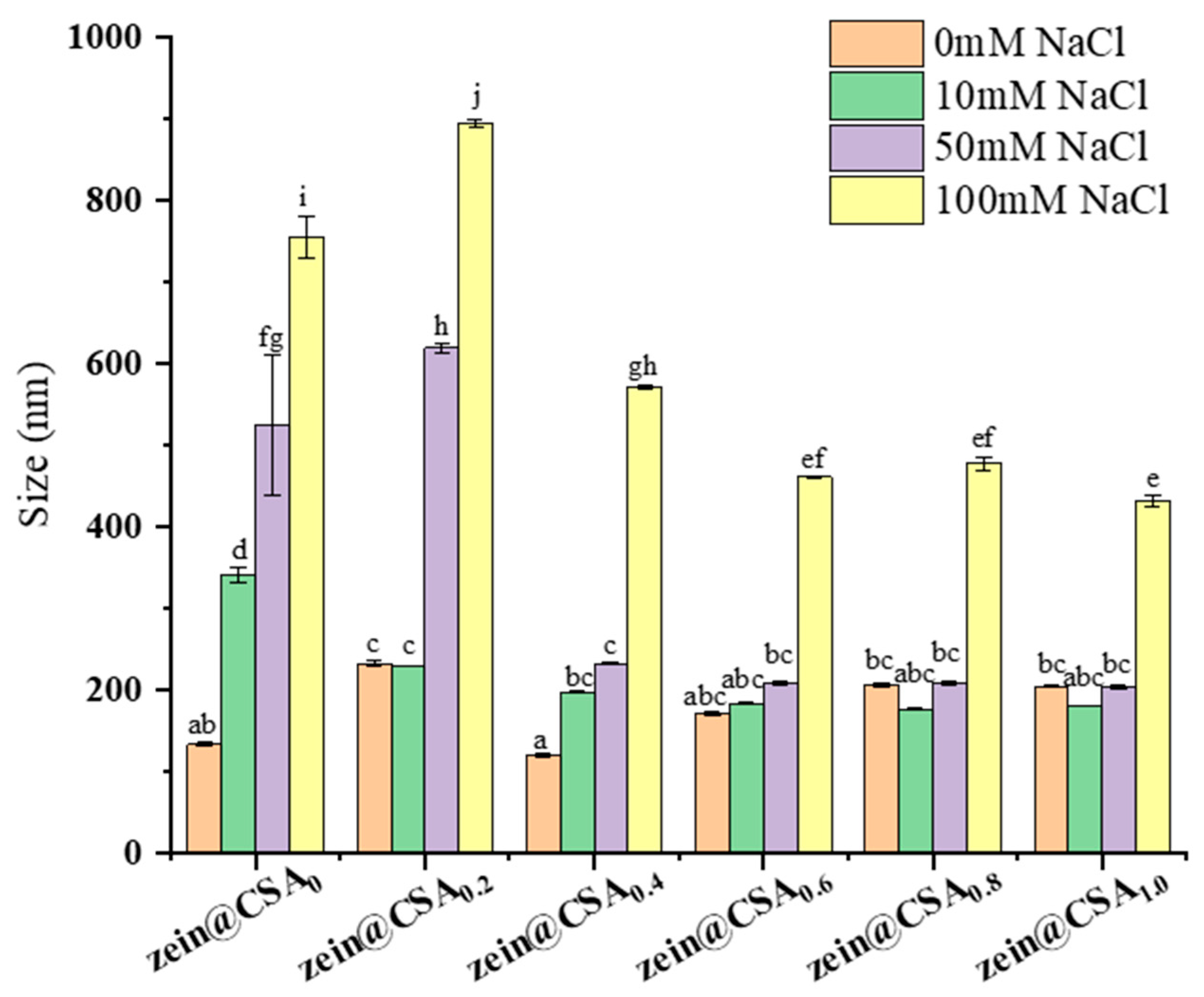
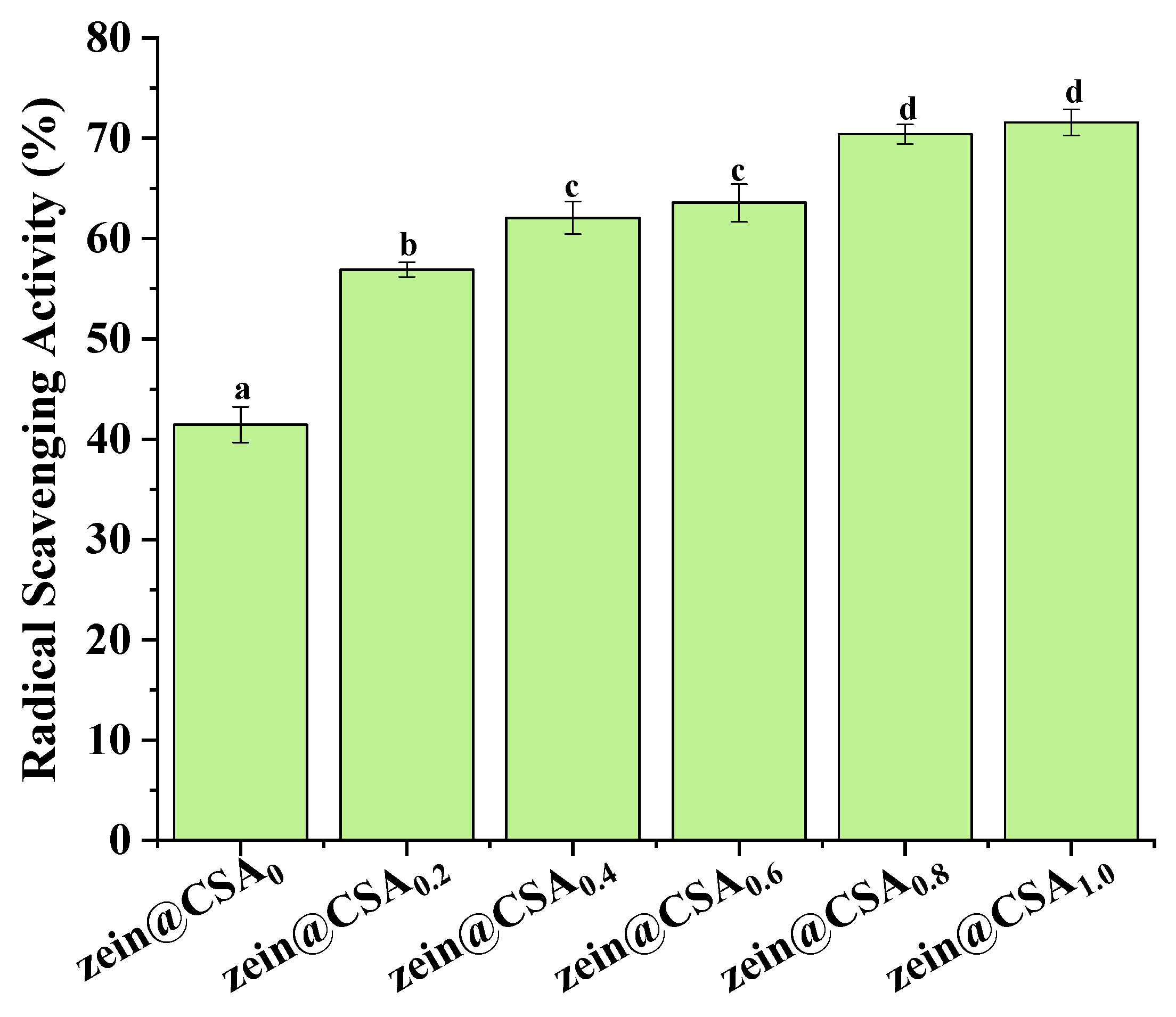

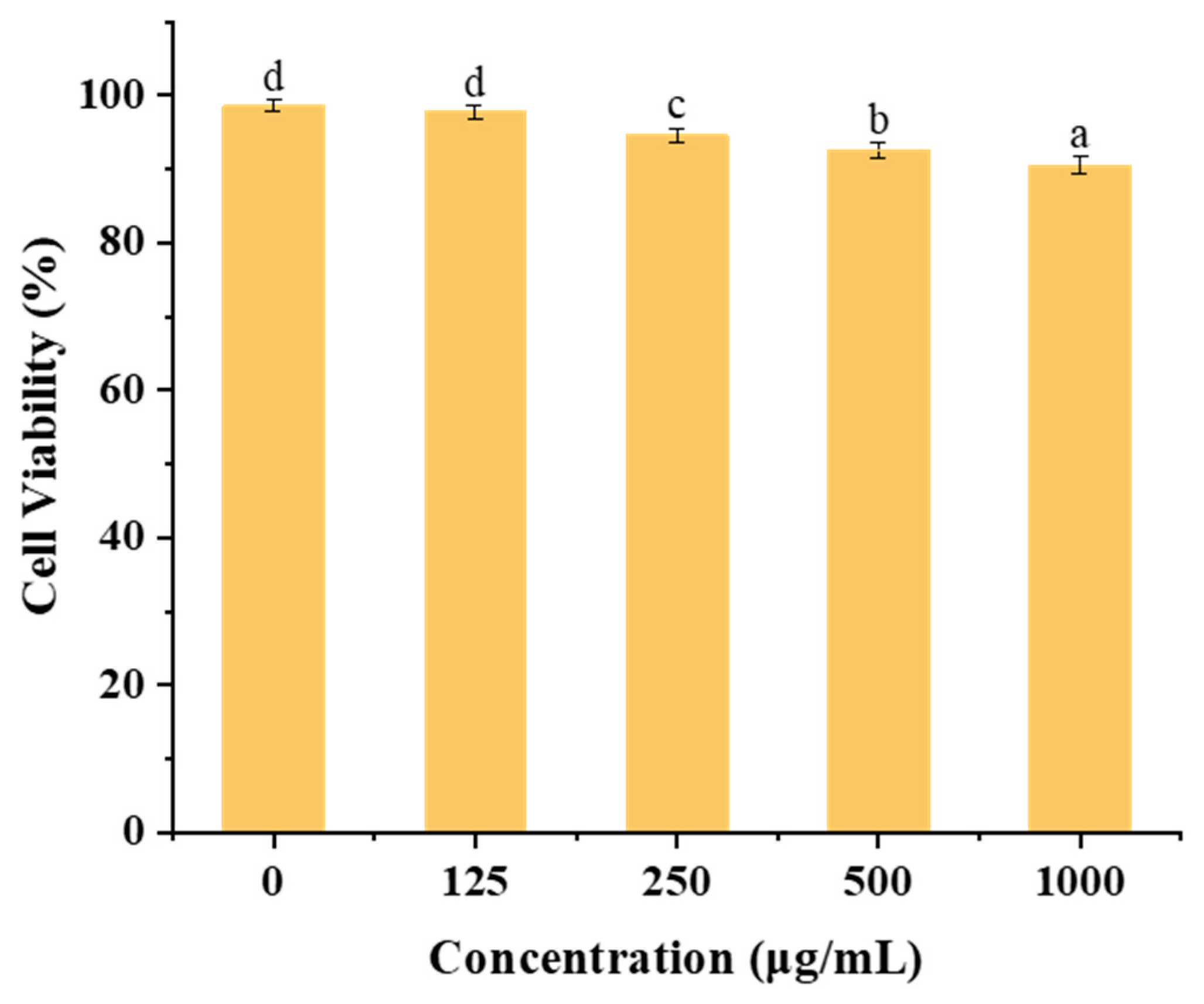
| Sample | EE (%) | LC (%) |
|---|---|---|
| zein@CSA0 | 33.82 ± 3.27 a | 3.76 ± 0.36 a |
| zein@CSA0.2 | 91.47 ± 3.86 b | 8.32 ± 0.35 d |
| zein@CSA0.4 | 91.19 ± 8.49 b | 7.01 ± 0.65 c |
| zein@CSA0.6 | 91.19 ± 8.21 b | 6.08 ± 0.55 bc |
| zein@CSA0.8 | 92.20 ± 1.45 b | 5.42 ± 0.09 b |
| zein@CSA1.0 | 96.47 ± 1.52 b | 5.09 ± 0.08 b |
Disclaimer/Publisher’s Note: The statements, opinions and data contained in all publications are solely those of the individual author(s) and contributor(s) and not of MDPI and/or the editor(s). MDPI and/or the editor(s) disclaim responsibility for any injury to people or property resulting from any ideas, methods, instructions or products referred to in the content. |
© 2024 by the authors. Licensee MDPI, Basel, Switzerland. This article is an open access article distributed under the terms and conditions of the Creative Commons Attribution (CC BY) license (https://creativecommons.org/licenses/by/4.0/).
Share and Cite
Lin, Z.; Zhan, L.; Qin, K.; Li, Y.; Qin, Y.; Yang, L.; Sun, Q.; Ji, N.; Xie, F. Design and Characterization of a Novel Core–Shell Nano Delivery System Based on Zein and Carboxymethylated Short-Chain Amylose for Encapsulation of Curcumin. Foods 2024, 13, 1837. https://doi.org/10.3390/foods13121837
Lin Z, Zhan L, Qin K, Li Y, Qin Y, Yang L, Sun Q, Ji N, Xie F. Design and Characterization of a Novel Core–Shell Nano Delivery System Based on Zein and Carboxymethylated Short-Chain Amylose for Encapsulation of Curcumin. Foods. 2024; 13(12):1837. https://doi.org/10.3390/foods13121837
Chicago/Turabian StyleLin, Zhiwei, Linjie Zhan, Kaili Qin, Yang Li, Yang Qin, Lu Yang, Qingjie Sun, Na Ji, and Fengwei Xie. 2024. "Design and Characterization of a Novel Core–Shell Nano Delivery System Based on Zein and Carboxymethylated Short-Chain Amylose for Encapsulation of Curcumin" Foods 13, no. 12: 1837. https://doi.org/10.3390/foods13121837
APA StyleLin, Z., Zhan, L., Qin, K., Li, Y., Qin, Y., Yang, L., Sun, Q., Ji, N., & Xie, F. (2024). Design and Characterization of a Novel Core–Shell Nano Delivery System Based on Zein and Carboxymethylated Short-Chain Amylose for Encapsulation of Curcumin. Foods, 13(12), 1837. https://doi.org/10.3390/foods13121837







